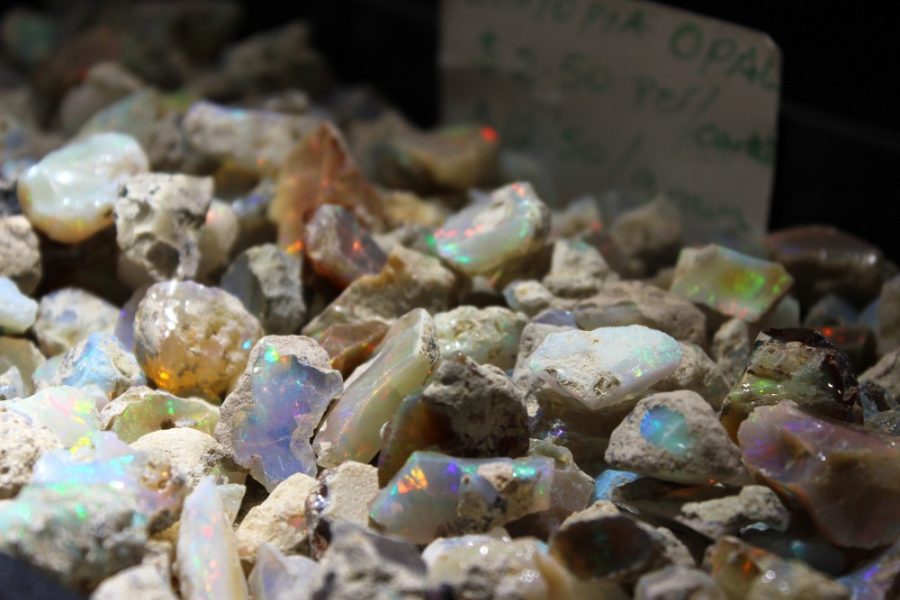If you’re not a geologist, a trip to the Tucson Gem Mineral and Fossil Showcase might just be a blur of glittery rocks and expensive jewelry. But with some of the world’s finest gems, minerals and fossils on display, it would be a shame not to take full advantage of the experience this year. These five facts will help you prepare to attend a show and truly get the most out of your experience.
1. Plant, Animal, Mineral?
If you’ve ever played 20 Questions, you already know minerals don’t fall under the same category as a plant or an animal.
“A mineral is a material that has a crystalline structure of a defined composition,” said Shaunna Morrison, UA geoscience graduate student and postdoctoral associate at the Carnegie Institution for Science.
Minerals can be formed in a variety of ways, said Carson Richardson, another graduate student in geoscience. They start out within the Earth’s crust, where magma chambers cool and crystallize different minerals out at varying times and temperatures.
Once the minerals are brought to the surface, a combination of weathering away, rain or ground water can transform them into different minerals, Richardson said.
2. Gems: Minerals’ Flashy Cousin
Ever wondered if what you were looking at was a gem or a mineral? The difference isn’t as big as you might think.
“Gems are very high quality, pure versions of certain minerals. They’re also different visually, as well,” Richardson said. “They typically form in the same ways minerals do, but some of them might form in very specific environments.”
The term “gem” usually refers to something that is transparent and without cracks, the type of stone that would be able to be cut and faceted for jewelry, Morrison said.
Many gemstones, such as ruby, sapphire and diamond, are considered more than just minerals only because of minute differences in chemical composition or conditions during formation. For example, when a tiny bit of titanium is added to the mineral quartz, it becomes the gemstone amethyst, Morrison said.
RELATED: Gem Show travelers bring economic boom to Tucson
3. Homegrown Gems
Although the theme for this year’s mineral show is “Mineral Treasures of the Midwest,” make sure to keep an eye out for minerals specific to Arizona.
“We [Arizona] produce 66 percent of the nation’s copper and 6 percent of all the copper produced in the world,” said Pam Wilkinson, educational outreach coordinator at the Lowell Institute for Mineral Resources.
Other minerals mined in Arizona include clay, coal, copper, dimension stone, gold, gypsum, limestone, marble, perlite, rhenium, salt, silver and uranium.
Mining also adds economic value and high-paying jobs to the state, in addition to providing our country with valuable minerals, Wilkinson said.
4. Worth Their Weight
In order to form a mineral, the right chemistry, temperature, conditions, fluids, pressure, environment and chemical components must be present, Morrison said.
“When you look at the minerals as they come out of the earth, all their crystal shapes, all their luster, their associations with other minerals; you’ll never find another piece just like that piece anywhere on Earth,” Wilkinson said.
Sometimes how rare a mineral is can make it valuable. Other times, it is their properties that add value.
Take, for example, diamonds, Morrison added. Diamonds are certainly not the rarest minerals on Earth, but their unique characteristics make them particularly expensive. As the hardest substance on Earth and often given to spectacular clarity, diamond can be used for anything from engagement rings to industrial grinding tools.
RELATED: Four UA researchers named Bisgrove Scholars
5. How to Shop
With so many shows happening around town, trying to pick the right one to attend can be overwhelming.
Wilkinson recommends the Tucson Gem and Mineral Society’s show from Feb. 9-12 if you’re new to the world of minerals. The dealers there have been vetted to ensure their legitimacy.
This is also the largest of all the local shows and often features particularly beautiful and expensive specimens.
The show provides educational opportunities for everyone, both young and old, Wilkinson said. Afraid of being duped? Wilkinson also had some tips for buying the perfect gem.
“I think with respect to shopping for things, you should shop for the things that speak to you, that you love, either by their color, their shape, how you feel when you hold them.” Buying things specifically because they look like they might be valuable is a good way to lose money.
If you’re looking for a display of minerals closer to campus, stop by the Flandrau Science Center and Planetarium to see their newest exhibit, “A Modern Gem and Jewelry Collection,” curated by the UA Mineral Museum, the American Gem Trade Association and the Gemmological Institute of Great Britain.
Follow Hannah Dahl on Twitter.

















